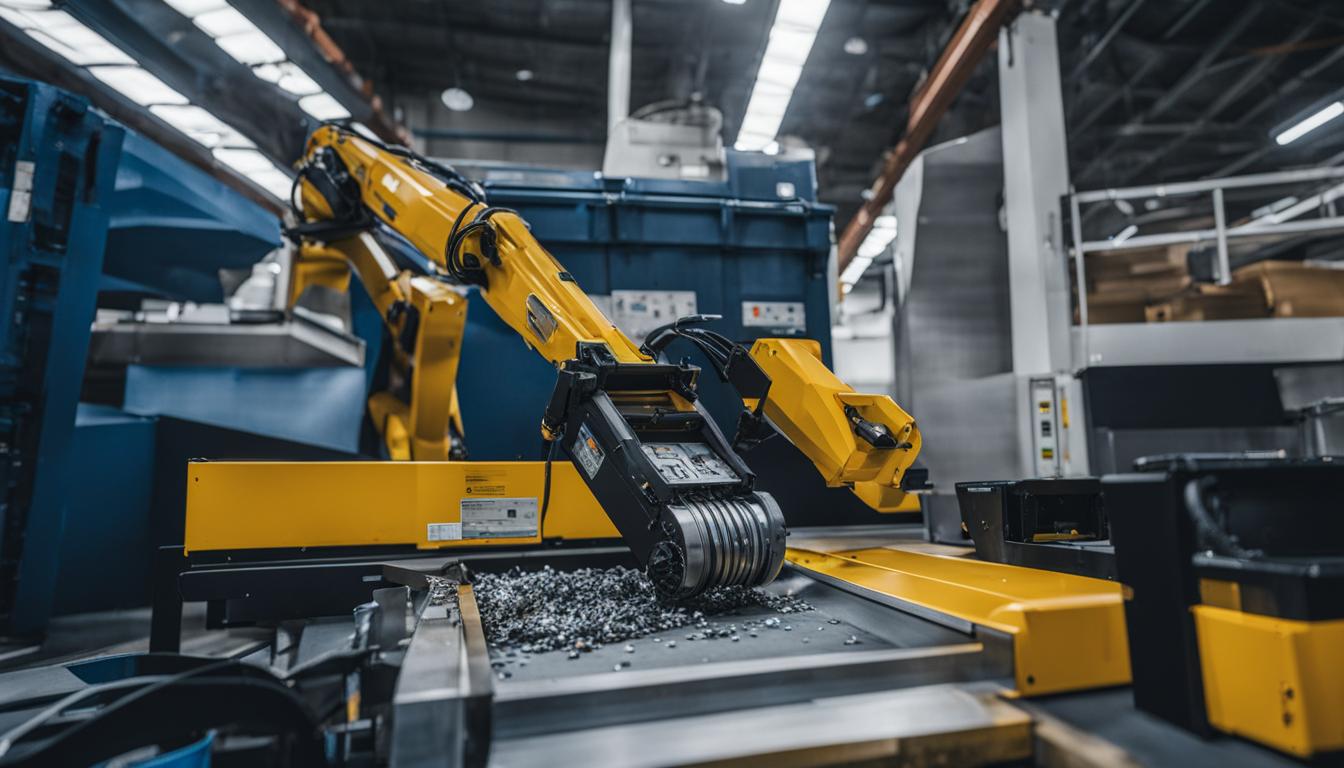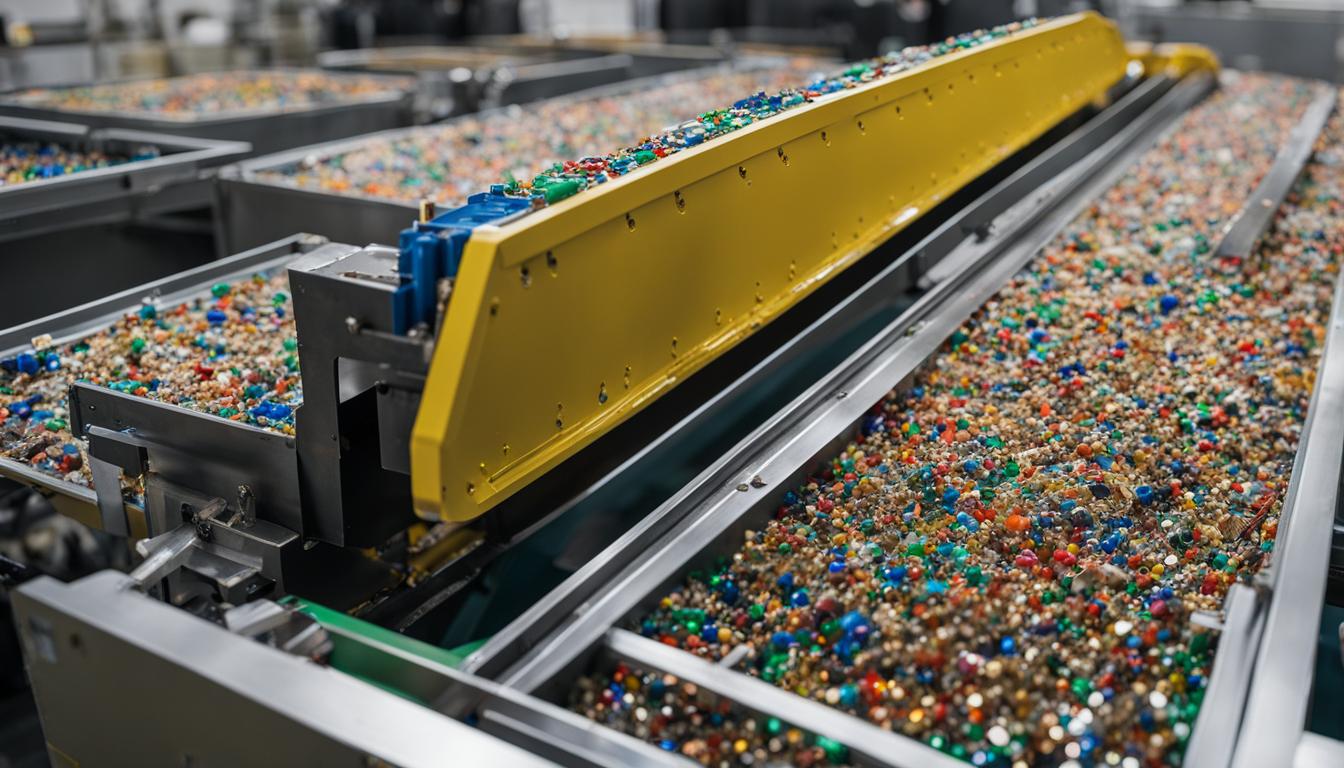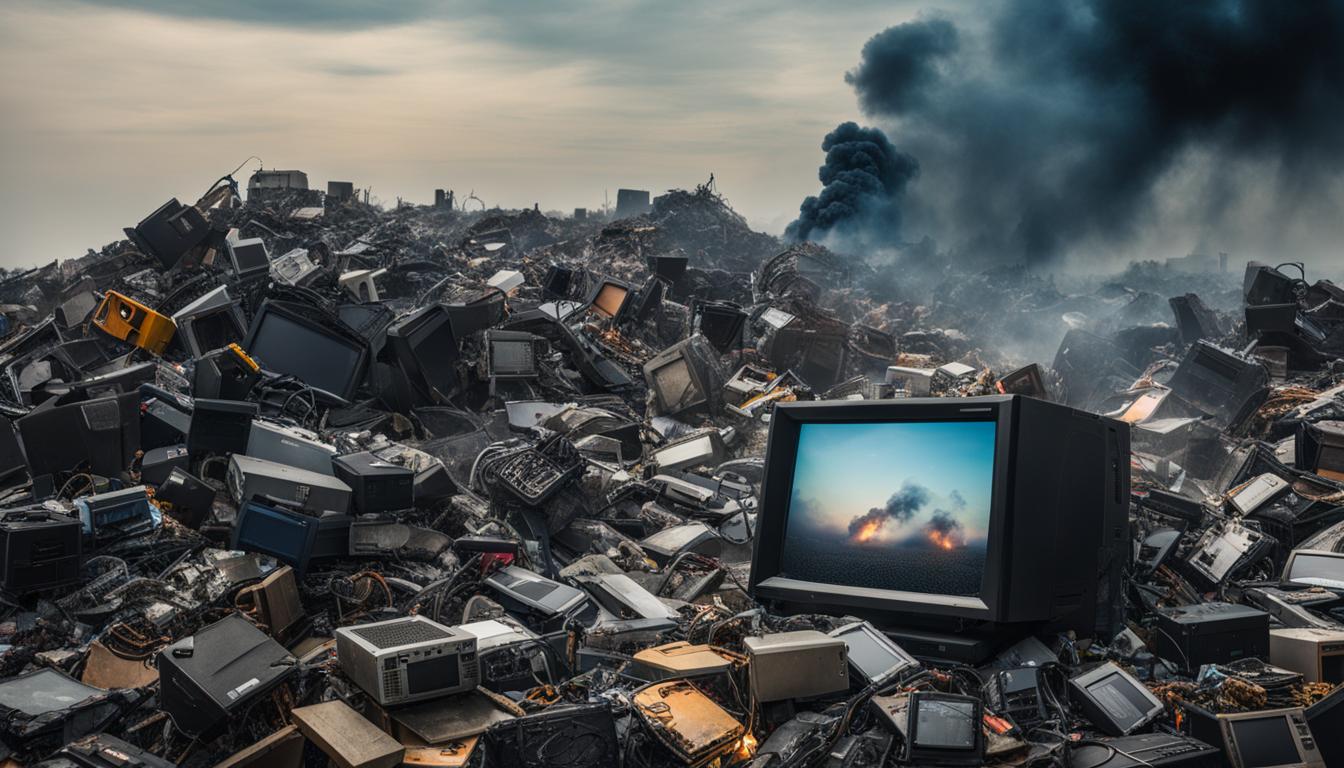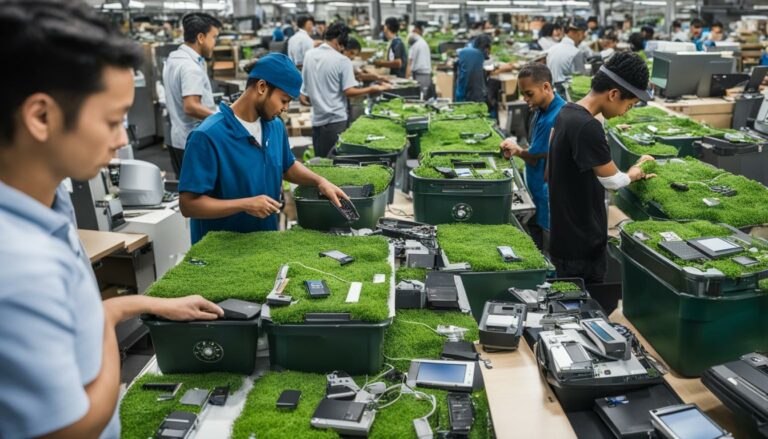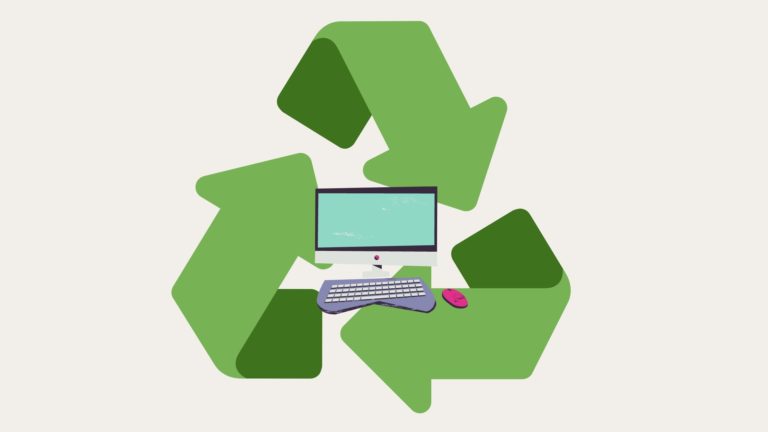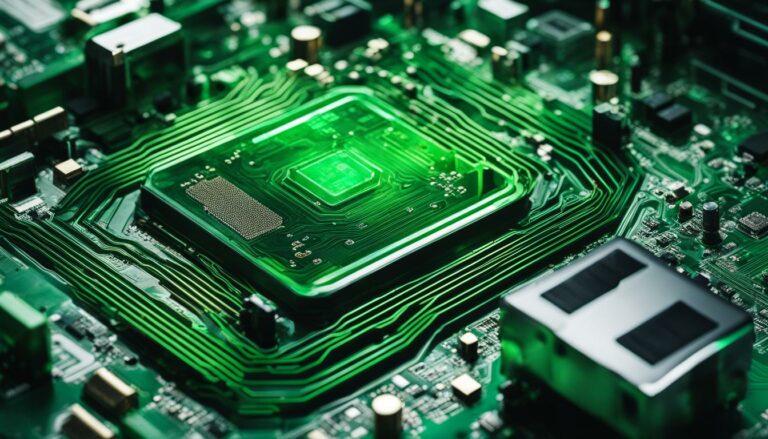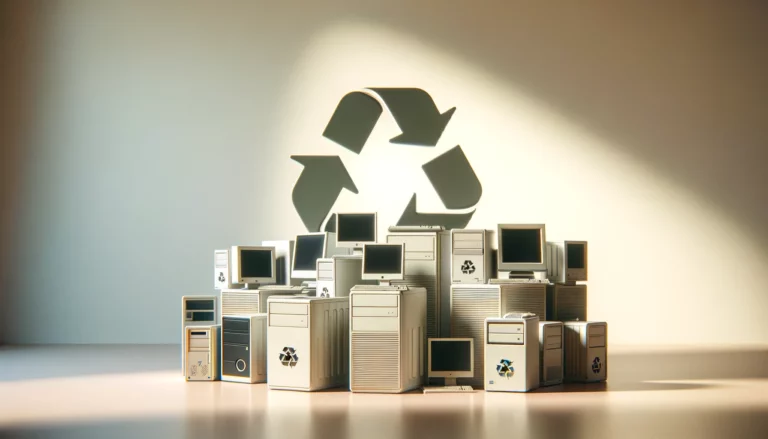A World Without E-waste: Imagining the Future
In our pursuit of a more sustainable future, envisioning a world without e-waste is essential. With electronic devices becoming outdated at an alarming rate, our throw-away culture is not only wasteful but also damaging to the environment. Did you know that in the UK, for every single phone in use, four sit unused? Furthermore, a staggering 50% of the devices we discard are still in perfectly working condition. However, only 20% of electronic waste is currently being recycled, making it the fastest-growing and most toxic waste stream globally. It’s time to reimagine a world where electronic waste is minimized and properly managed, leading us towards a more sustainable and e-waste-free future.
Key Takeaways:
- E-waste is the fastest-growing and most toxic waste stream globally
- 50% of discarded devices are still functional
- Only 20% of electronic waste is currently being recycled
- Minimizing electronic waste requires a shift towards a more circular economy
- Individual and community actions, as well as corporate responsibility, are crucial in reducing e-waste
The Impact of E-waste on the Environment and Health
The improper disposal of e-waste has severe impacts on both the environment and human health. Toxic substances from discarded electronics can contaminate the soil and water, posing risks to plants, animals, and humans. Electronic waste also contributes to resource depletion, as valuable materials are wasted instead of being recycled. Implementing effective e-waste management strategies and proper electronic waste disposal is crucial for reducing the harmful effects on the environment and protecting public health.
E-waste contains hazardous substances such as lead, mercury, cadmium, and brominated flame retardants. When improperly disposed of in landfills or incinerated, these toxins can leach into the soil and water. This contamination can disrupt ecosystems, harm biodiversity, and enter the food chain, posing risks to both wildlife and humans. Additionally, the burning of electronic waste releases toxic chemicals into the air, contributing to air pollution and respiratory issues.
Resource depletion is another significant consequence of improper e-waste disposal. Electronic devices contain valuable materials like gold, silver, copper, and rare earth elements. When not recycled, these resources are wasted, and the demand for new materials increases. By implementing effective recycling systems, we can recover these valuable components and reduce the need for extracting and processing virgin resources, thereby conserving energy and reducing carbon emissions.
“Proper e-waste management is essential to prevent the negative impacts of electronic waste on the environment and health. By adopting responsible disposal methods and promoting electronic waste recycling, we can minimize pollution, conserve resources, and create a more sustainable future for all.”
| E-waste Management Strategies | Benefits |
|---|---|
| Establishing dedicated e-waste collection centers | Facilitates proper disposal and recycling of electronic waste |
| Implementing legislation and regulations for e-waste management | Ensures compliance and accountability |
| Promoting consumer awareness and education | Encourages responsible disposal and recycling behavior |
| Supporting the development of e-waste recycling facilities | Creates employment opportunities and fosters a circular economy |
Moving Towards a Circular Economy for Electronics
To create a more sustainable future, we need to transition from a linear economy to a circular economy for electronics. This means designing products that are built to last, promoting repair and reuse, and implementing effective recycling systems. By recycling electronic devices, we can extract valuable components and materials for use in new products, reducing the demand for new resources. Embracing sustainable electronics and adopting eco-friendly practices will help us create a more circular economy and minimize electronic waste.
The Importance of Recycling Electronic Devices
Recycling electronic devices is a key step towards reducing electronic waste and conserving valuable resources. These devices contain precious metals, such as gold, silver, and palladium, as well as rare earth elements that can be extracted and reused. By recycling these materials, we can reduce the need for mining and minimize the environmental impacts associated with resource extraction. Additionally, recycling electronic devices helps prevent hazardous substances, such as lead, mercury, and cadmium, from polluting the environment and posing risks to human health. It is essential that we promote and invest in effective recycling systems to ensure the proper disposal of electronic waste.
Designing for Durability and Repairability
A crucial aspect of moving towards a circular economy for electronics is designing products that are built to last and easy to repair. This involves creating devices with modular components that can be easily replaced or upgraded, extending their lifespan. By prioritizing durability and repairability, we can reduce the frequency of device replacements and minimize electronic waste. Encouraging manufacturers to adopt design principles that prioritize longevity and repairability will contribute to a more sustainable electronic industry.
Promoting Reuse and Second-hand Markets
In addition to recycling, promoting reuse and second-hand markets for electronic devices is another important aspect of transitioning to a circular economy. Many devices can still be used after being refurbished or repaired, extending their lifespan and reducing the overall demand for new products. By supporting second-hand markets and encouraging consumers to consider pre-owned devices, we can reduce electronic waste and conserve resources. Collaborations between manufacturers, retailers, and refurbishers can help create a robust and trusted second-hand market for electronic devices.
In conclusion, moving towards a circular economy for electronics is crucial for reducing electronic waste and promoting sustainability. By recycling electronic devices, designing for durability and repairability, and promoting reuse and second-hand markets, we can minimize the environmental impact of the electronic industry and conserve valuable resources. It requires a collective effort from manufacturers, consumers, and policymakers to embrace sustainable electronics and adopt eco-friendly practices. Together, we can create a more circular and sustainable future.
Innovative Solutions for E-waste Reduction
When it comes to tackling the issue of electronic waste, innovative solutions are emerging to minimize its impact on the environment and create a more sustainable future. Various companies and organizations are actively working towards reducing e-waste through targeted initiatives and programs.
“We believe in the power of repair and reuse to extend the lifespan of electronic devices and minimize e-waste. Our convenient collection programs allow individuals to properly dispose of their unused or broken devices, which are then repaired by skilled engineers. If a device cannot be fixed, we ensure its proper disposal and recycling through advanced recycling partners,” says Sarah Thompson, CEO of EcoTech Solutions.
One such solution is the establishment of convenient collection programs, where individuals can responsibly dispose of their unused or broken devices. These programs ensure that devices are either repaired, redeployed to those in need, or sent for proper recycling. By extending the lifespan of devices through repair and reuse, we can significantly reduce electronic waste.
Furthermore, collaboration between organizations, such as schools, SMEs, and consumers, is essential in promoting sustainable practices. By working together, we can create a network of responsible electronic waste management, ensuring that devices are properly recycled and their valuable components are extracted for use in new products. This collaborative effort plays a crucial role in moving towards a more sustainable and e-waste free future.
| Initiative | Description |
|---|---|
| Convenient collection programs | Allows individuals to properly dispose of their unused or broken devices for repair or recycling |
| Skilled engineers repair | Devices are repaired by competent engineers to extend their lifespan |
| Redeployment | Reliable and affordable devices are redeployed to schools, SMEs, and consumers |
| Proper disposal and recycling | Devices that cannot be fixed are sent to advanced recycling partners for responsible disposal and recycling of their components |
These innovative solutions and collaborative efforts aim to reduce e-waste, promote sustainability, and pave the way for a future where electronic waste is no longer a pressing concern. By embracing these initiatives, we can move closer to a world where sustainable technology is the norm, and electronic waste is a thing of the past.
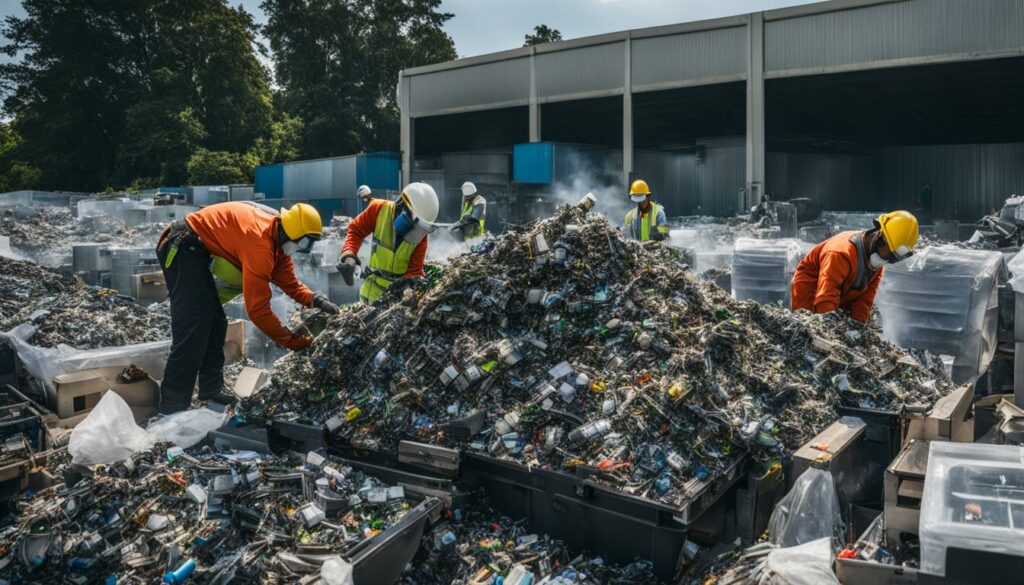
Individual and Community Actions to Tackle E-waste
Reducing electronic waste is a collective responsibility that individuals and communities can actively contribute to. By taking specific actions, we can make a significant impact on minimizing e-waste and creating a more sustainable future. Here are some key ways individuals and communities can tackle e-waste:
1. Opt for responsible disposal and recycling
When disposing of electronic devices, it is important to choose responsible options such as recycling instead of throwing them away. Many recycling programs and centers accept electronic waste and ensure that it is properly recycled or disposed of. By participating in such programs, you can ensure that your devices are handled in an environmentally friendly manner, minimizing the impact on the planet.
2. Support circularity in the electronics industry
Advocating for a circular economy in the electronics industry is crucial for reducing e-waste. This involves promoting repair and reuse of devices, as well as encouraging manufacturers to design products that are built to last. By supporting companies that prioritize sustainability and circularity, you can contribute to the shift towards a more environmentally friendly and sustainable electronic ecosystem.
3. Prioritize repair and reuse
Extending the lifespan of electronic devices through repair and reuse is another effective way to reduce e-waste. Instead of immediately discarding a malfunctioning device, consider repairing it or donating it to organizations that can refurbish and redistribute it. By embracing a culture of repair and reuse, we can minimize the need for new electronic devices and reduce the overall amount of e-waste generated.
4. Promote awareness and education
Education and awareness play a crucial role in tackling the e-waste crisis. By spreading knowledge about the impacts of electronic waste and the importance of responsible disposal and recycling, individuals can encourage others to take action. This can be done through community outreach programs, social media campaigns, or even by participating in e-learning courses that focus on sustainable technology and e-waste management.
By implementing these actions at an individual and community level, we can collectively make a difference in reducing electronic waste. Together, we can work towards a more sustainable future where e-waste is minimized, and valuable resources are preserved.
| Action | Description |
|---|---|
| Opt for responsible disposal and recycling | Choose proper recycling programs to ensure electronic devices are disposed of in an environmentally friendly manner. |
| Support circularity in the electronics industry | Promote repair, reuse, and sustainable design in the electronics industry to reduce the generation of e-waste. |
| Prioritize repair and reuse | Extend the lifespan of electronic devices through repair and donation rather than immediate disposal. |
| Promote awareness and education | Spread knowledge about the impacts of electronic waste and responsible e-waste management to encourage action. |
Educating and Empowering Through E-learning Courses
E-learning courses play a crucial role in educating and empowering individuals to tackle the e-waste crisis. These courses provide valuable insights into the impacts of electronic waste and equip learners with knowledge and skills to contribute to better e-waste management and support the adoption of sustainable technology.
One such course is “How to Prevent E-waste,” which covers a range of topics essential for understanding and combating the e-waste problem. Participants gain an understanding of the environmental and health impacts of electronic waste, as well as the importance of responsible disposal and recycling. By enrolling in this course, individuals can learn about innovative solutions and best practices for reducing e-waste.
“The course provided me with a comprehensive understanding of the e-waste crisis and practical steps I can take to make a difference. It highlighted the importance of recycling and repair, and I now feel empowered to tackle the issue in my own community.” – Jane, course participant
These e-learning courses go beyond theoretical knowledge and provide individuals with actionable steps to implement in their daily lives. From promoting repair and reuse to advocating for a zero e-waste society, participants gain the necessary tools to drive change and create a more sustainable future.
Corporate Responsibility and Collaboration for E-waste Reduction
As the urgency to tackle the e-waste crisis grows, many companies are embracing their responsibility towards responsible e-waste management. Corporate social responsibility is no longer just a buzzword but a driving force behind initiatives to reduce electronic waste and promote a greener future. By taking action and collaborating with other organizations and charities, companies can make a significant impact in minimizing e-waste and implementing effective solutions for its management.
One of the key ways companies can contribute to e-waste reduction is by sourcing refurbished IT for their workplaces and donating obsolete equipment. Instead of discarding old devices, these companies ensure that they are properly recycled or repurposed, reducing the overall electronic waste generated. This approach not only helps companies achieve their sustainability goals but also sets an example for others to follow, creating a ripple effect in the industry.
Collaborations between companies, organizations, and charities are crucial in addressing the complex challenges of e-waste management. By pooling their resources and expertise, these entities can develop innovative solutions and explore new avenues for reducing electronic waste. Whether it’s through joint recycling programs or sharing best practices, collaboration enables the collective effort needed to make a meaningful difference in minimizing e-waste and creating a more sustainable future.
| Benefits of Corporate Responsibility and Collaboration for E-waste Reduction |
|---|
| 1. Minimize electronic waste |
| 2. Achieve sustainability goals |
| 3. Set an example for industry peers |
| 4. Encourage responsible recycling and repurposing of electronic devices |
| 5. Foster innovation and development of effective e-waste management strategies |
By embracing corporate responsibility and collaborating with others, companies can contribute to the ongoing efforts of e-waste reduction. Together, we can create a more sustainable future and ensure that electronic waste is managed in a responsible and environmentally-friendly manner.
Conclusion
Imagining a future without e-waste is not only possible but necessary for a sustainable and greener world. By adopting innovative solutions, embracing circular economy principles, taking individual and community actions, and promoting education and collaboration, we can work towards an e-waste free future.
It requires collective effort, both from individuals and organizations, to reduce electronic waste, recycle responsibly, and promote sustainable electronics. Together, we can create a better world for future generations, where electronic waste is minimized and the Earth’s resources are used wisely.
Let us strive for an e-waste free future, where electronic devices are built to last, and our throw-away culture becomes a thing of the past. By envisioning and working towards this vision, we can pave the way for a more sustainable and environmentally conscious society.
FAQ
What is e-waste?
E-waste refers to discarded electronic devices such as phones, computers, and televisions. These devices contain valuable materials and components that can be recycled, but if not properly managed, they can have harmful effects on the environment and human health.
How does improper disposal of e-waste impact the environment and health?
Improper disposal of e-waste can lead to the contamination of soil and water with toxic substances from discarded electronics. This poses risks to plants, animals, and humans. E-waste also contributes to resource depletion as valuable materials are wasted instead of being recycled.
What is a circular economy for electronics?
A circular economy for electronics involves designing products that are built to last, promoting repair and reuse, and implementing effective recycling systems. This approach aims to minimize electronic waste by extracting valuable components and materials from old devices for use in new products, reducing the demand for new resources.
How can individuals and communities reduce e-waste?
Individuals and communities can reduce e-waste by opting for responsible disposal of electronic devices and choosing to recycle them instead of throwing them away. Repairing and reusing devices also extends their lifespan. Additionally, supporting and influencing industry players and lawmakers to prioritize circularity in the electronic industry is vital.
How do e-learning courses contribute to tackling the e-waste crisis?
E-learning courses, such as “How to Prevent E-waste,” provide knowledge and insights into the impacts of electronic waste and ways to reduce it. These courses cover topics such as recycling, reuse, repair, and promoting a zero e-waste society. By participating in these courses, individuals can gain the skills and knowledge to contribute to better e-waste management and support the adoption of sustainable technology.
How can companies contribute to reducing e-waste?
Companies can contribute to reducing e-waste by sourcing refurbished IT for the workplace and donating obsolete equipment. This promotes sustainability and corporate social responsibility goals. Collaborations between companies, organizations, and charities are also essential for implementing effective e-waste reduction strategies.



